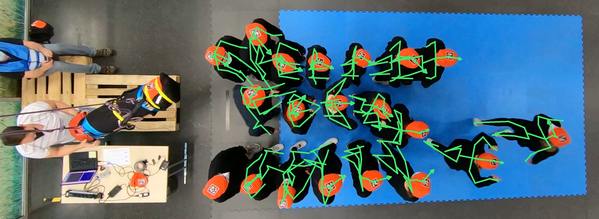3D Motion in Crowds
For the understanding of the dynamics inside crowds, reliable empirical data are needed, which could increase safety and comfort for pedestrians and the design of models reflecting the real dynamics. To analyze effects like clogging, overtaking or the threading into a bottleneck the orientation of body parts like shoulder, pelvis, arms and feet are of high interest.
In dense crowds a well-calibrated camera system can extract absolute head positions with high accuracy. The inclusion of inertial sensors or even self-contained full-body motion capturing (mocap) systems allows the relative tracking of body parts or even capturing the locomotion of the whole body.
To capture the 3D motion of people inside a crowd relative to surrounding people movement data of both systems have to be fused.
Therefore, we developed a hybrid system mapping the trajectory of the top of the head coming from a full-body mocap system to the head trajectory of a camera system in global space. The hybrid system combines the best of out of both worlds: the correct absolute position of each person in the scene coming from the camera system and detailed relative motion coming from an inertial measurement based full body mocap system.
The following picture shows an overlay of stick figure representations from the mocap system, superimposed on a snapshot from an overhead video used for absolute head detection.

The fused data enable the analysis of possible correlations of all observables and opens up new possibilities for analyzing pedestrian dynamics inside crowds, such as the space requirement while passing a bottleneck.
The system also allows linking any body motion to characteristics describing the situation of a person inside a crowd, such as the density or movements of other participants nearby.
For an experiment of people passing a bottleneck the following figure shows by example the influences of bottleneck width (w increasing from top to bottom) and motivation (h- low (left) and h0 high (right)) on the overall movement.
The path of the head (blue) shows the movement of one person walking from right to left within a dense crowd through that bottleneck (grey area).

Related article:
Hybrid-System:
Maik Boltes, Juliane Adrian and Anna-Katharina Raytarowski: A Hybrid Tracking System of Full-Body Motion Inside Crowds, Sensors 2021, 21(6), 2108, https://doi.org/10.3390/s21062108
Results:
Boomers, Ann Katrin, Maik Boltes, and Uwe G. Kersting. “How Approaching Angle, Bottleneck Width and Walking Speed Affect the Use of a Bottleneck by Individuals.” Sensors 24, no. 6. 2024: 1720. https://doi.org/10.3390/s24061720.
Feldmann, Sina, Thomas Chatagnon, Juliane Adrian, Julien Pettré, and Armin Seyfried. “Temporal Segmentation of Motion Propagation in Response to an External Impulse.” Safety Science 175. 2024: 106512. https://doi.org/10.1016/j.ssci.2024.106512.
Feldmann, Sina, Juliane Adrian, and Maik Boltes. “Propagation of Controlled Frontward Impulses Through Standing Crowds.” Collective Dynamics 9. 2024. https://doi.org/10.17815/CD.2024.148.
Feldmann, Sina, and Juliane Adrian. “Forward Propagation of a Push through a Row of People.” Safety Science 164. 2023: 106173. https://doi.org/10.1016/j.ssci.2023.106173.
Boomers, Ann Katrin, and Maik Boltes. “Shoulder Rotation Measurement in Camera and 3D Motion Capturing Data.” In Traffic and Granular Flow ’22, 35–42. 2024. https://doi.org/10.1007/978-981-99-7976-9_5.
Schumann, Jette. “Utilizing Inertial Sensors as an Extension of a Camera Tracking System for Gathering Movement Data in Dense Crowds.” Bergische Universität Wuppertal, 2022. https://juser.fz-juelich.de/record/908324.
Software for camera tracking and stick figure visualization:
PeTrack: https://ped.fz-juelich.de/petrack
Data:
Forschungszentrum Jülich, Institute for Advanced Simulation. “Data Archive of Experiments on Pedestrian Dynamics,” https://doi.org/10.34735/ped.da.
